Family Pictures USA was invited by the African American Museum in Philadelphia for their monthly Macy’s Family Fun Day to host a full day of photo-sharing sessions with the community. People of all ages came with their photographs to share their Philly stories as well as their family’s diaspora, giving us personal insights into the City of Brotherly Love through the family album. Check out our photo album to see what transpired that day!
Patricia Silva reached out to us after just missing our photo-sharing event, hoping she would still have the chance to share her story with the world. With a few of her favorite family photos, she shares with us what it was like for her and her family to move to Philadelphia all the way from Portugal.
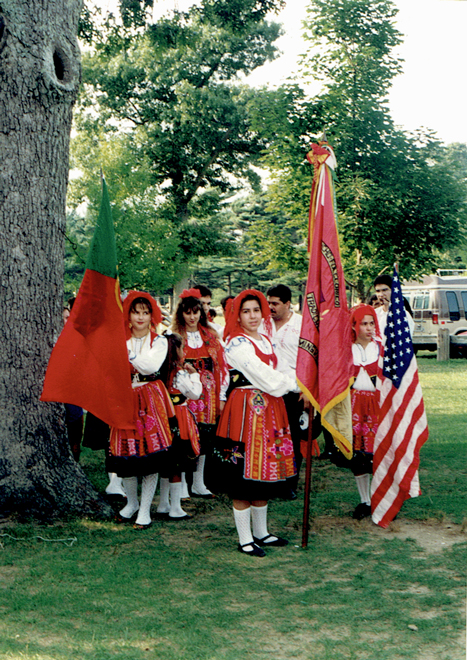
Traditional Portuguese folkloric group from New Jersey at a Portuguese Independence Day event at Heckscher State Park, 1996.
“The first time I saw City Hall was out the window of a ‘76 Volkswagen Scirocco. That excursion, like shorter ones to come, was a blur. Beaming with joy that we were finally here, my dad drove us around in Philadelphia, showing us the famous Bell, Rittenhouse Square, and the masonry of City Hall. Dad pointed to these places with pride but they were all seen from afar. Their histories remained mute to us. After that initial tour the only rides we took in the Scirocco were mostly to the Portuguese club or the ‘Penny Fruit’ supermarket.
When mom, my brother Rodrigo, and I arrived to the U.S. in 1987, Fifth Street – between Rockland and Lindley – was teeming with Portuguese immigrants. From the back seat I saw signs for pastries, roasted lamb, skinned rabbits, restaurants, travel agencies, and a bakery.
This compression was all very surprising because my ideas about the United States had been shaped by commercials for programs we rarely saw: Dallas and Dynasty. Compared to the cobblestone streets where small cars folded in their side mirrors to enter, Center City Philadelphia was vastly more spacious than downtown Lisbon. We had heard the U.S. was big, very big! And for all we knew, those wide landscapes we glimpsed from Dallas commercials were just a short drive away, maybe thirty minutes. The house our dad bought in 1979 was on a modest and quiet street of row homes in Feltonville.
Three or four years before we joined my dad in that house, he sent us a matching pair of Eagles jackets for Christmas while we were still in Portugal. We could not resolve the astro quality of those silver sleeves with anything we owned, or with the jacket itself. For that matter, we just didn’t get it. In the parish where we lived, at the rural edges of Lisbon’s district, drawing attention to oneself was inherently a bad thing. Making a spectacle was frowned upon in a land where social performances are predictably in sync.
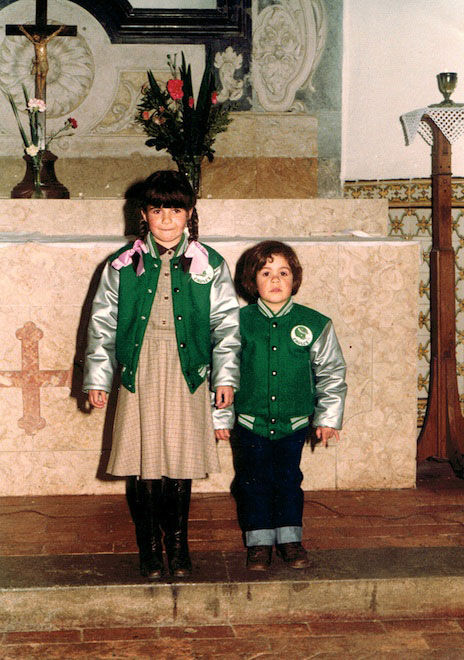
Patricia and brother Rodrigo, in Portugal, 1985.
To become individualized is to fall prey to egotism, but there we were: two kids wearing these garish jackets because Dad sent them. We didn’t like wearing them, much less sporting them at the same time—Ridicule, party of two!
Our picture is styled by the gestures of social pressure. The ironed pink ribbons, two taut braids, and the aggressive green and silver tone of the sports jacket. A dainty curl of hair on an otherwise bare forehead. We are posing for someone unknown as much as we are standing away from all we know.
We didn’t have a camera in the family. Photographs were mostly given to us and stored in paper envelopes in the top drawer of mom’s dresser. Some of them were purchased from photographers at weddings, baptisms, formal occasions like that. The camera was only present for commemorations. And so, we reliably knew when we would be photographed. Mom regularly mailed pictures of us to Dad throughout the eight years they were separated. We knew our faces crossed the ocean, wrapped in a letter, flattened into the envelope. In 1983 or ’85, we attended a baptism at the local church, the one our grandfather had been a foreman at, and Mom made us wear those famous jackets specifically for the photograph. It’s the only picture we have of us wearing them. Rodrigo and I didn’t connect the jackets to Philadelphia until we saw that symbol everywhere once we moved to East Eleanor Street.
In late March of 1987, my brother and I boarded our first airplane with mom. Every minute of that direct flight from Lisbon was tense with anticipation. But not even the stifling stench of cigarette smoke from another cabin was going to dull the inner shine we held for a new, and better, life.
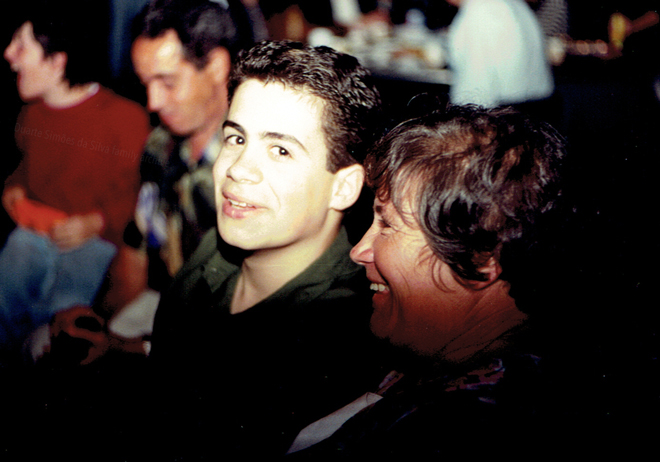
Mom and Rodrigo at Newark, New Jersey, in 1994.
We landed at JFK International Airport and Dad drove us to Feltonville, Pennsylvania that night. Within one month of living there, my dad got a new job in Massachusetts. We moved away but returned to Feltonville on weekends so Dad could fix up the house and try to sell it. Giddy with hope, a reunited family got real close and comfy with all the traffic jams along the Ben Franklin Parkway and the Mass Pike. Traffic was our island, a long stretch of heat away from discord.
At thirteen and ten, me and Rodrigo familiarized ourselves with all the newness in Philly. As was our way, we created adventures. Expeditions to delis, candy stores, and a pharmacy where we flipped through magazines without buying them. We were reprimanded several times but we didn’t yet speak English and therefore pretended to also not understand the language of disapproval from the middle-aged manager as we spent quarters of the hour with Rolling Stone, Mademoiselle, National Geographic (me), cycling, and car magazines (Rodrigo).
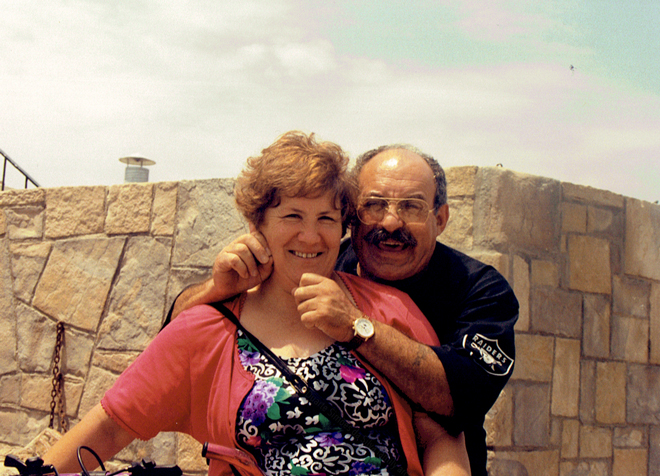
Mom and Dad in Portugal during 1990s.
From the ‘community penny jar’ in the living room, filled with seven years’ worth of copper, we only needed six cents for six pieces of Swedish Fish at the candy store on D Street. Highlight of our day! Sensitive to the repetition of words, we noticed people saying ‘hoagie’ and getting something that resembled some kind of sandwich. We were curious to eat one but weren’t allowed to eat outside the house. Yet, powered by fistfuls of copper, we shared unbranded soft drinks in thin white plastic containers filled with a blue and purple liquid that made the back of my brother’s throat itch.
The word ‘hoagie’ became a cultural monument to us. We practiced saying ‘hoagie’ so many times that, eventually, just saying it became an act of comedy. By practicing that word we learned how to modulate our breath for words that begin with ‘h,’ which varied from the bare silence with which we were taught to shape H sounds. To this day, my dad pronounces ‘herbs’ with the same verbal sail as ‘hoagie’ whereas my brother and I wonder how ‘herbs’ managed to escape the English H treatment.
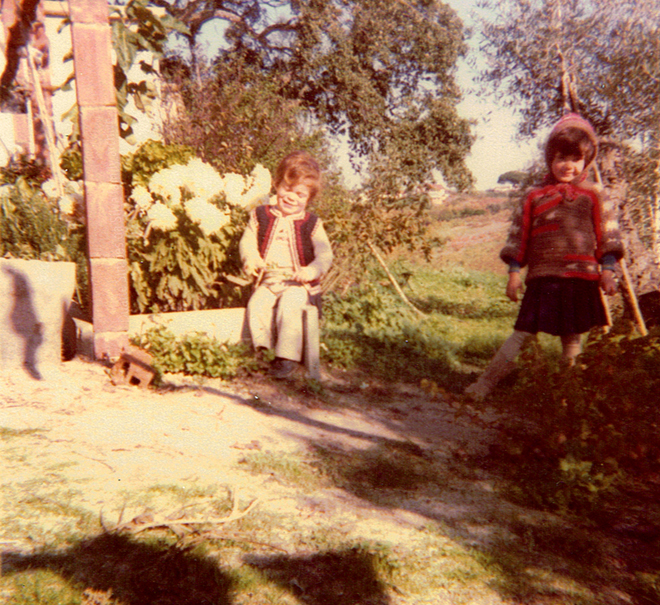
Patricia with Rodrigo in Portugal, 1983.
I often think of us walking down East Eleanor street, at thirteen and ten, holding back laughter as we expanded and contracted the contours of each consonant in ‘hoagie.’
Every light post we passed was plastered with photocopied flyers showing Mumia Abu-Jamal’s smiling face, and “Free Mumia” in bold type. We had no idea what that meant: that the face of one of the world’s most famous political prisoners and of America’s most controversial legal cases was, literally, the only smile we ever saw on the streets of Feltonville. Ours wasn’t the kind of street where kids played outside. In fact, we saw very few kids. I remember seeing our neighbors, mostly elderly, only when the mail delivery came around or when it was time to drop bin liners into metal pails. At night, we heard freestyle blasting over car engines and wheezing mufflers. Rodrigo learned how to ride his first bicycle in the back lot of the house, under the sway of Chuck Taylors and high top Reeboks hanging from electricity lines.
My brother became a cyclist, and me an artist. In 1999 and 2004, we both fulfilled our parents’ top dream for each of us: earning a college degree. After that, the Eagles winning the Superbowl in 2017 is probably the next best thing in my dad’s life.”
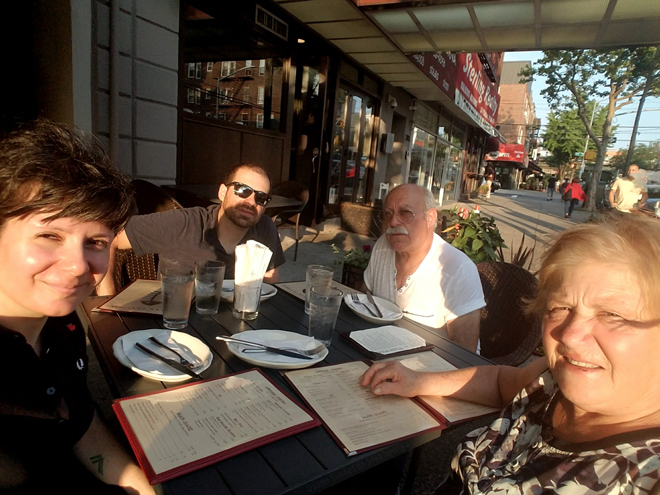
The Silva family out for lunch in Queens, NY, 2017.
Patricia Silva is a Lisbon-born, New York-based artist and creative producer who has been rediscovering Philadelphia as an adult. In collaboration with artists and academic partners, Patricia has co-produced feminist filmmaking workshops; a ten-episode podcast series, Radical Encounter; and developed photography workshops throughout Queens, New York.
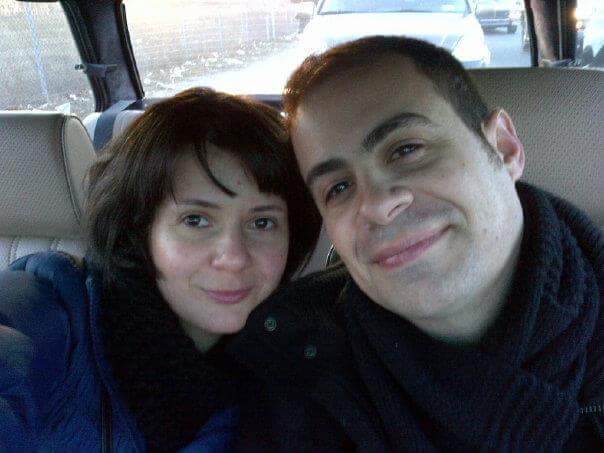
Patricia and Rodrigo in New York, 2015.
Their photographs have been exhibited in group shows at Flux Factory, USA; the Berlin Biennale, Berlin, Germany, and recently published in Der Grief Number 10, the 10th Anniversary Issue. Videos have screened at Anthology Film Archives, USA; MIT List Visual Arts Center, USA; Contemporary Art Center, Scotland; British Film Institute, UK; MoMA PS1 Theater, USA; IFC Theater, USA; Colorado Photographic Arts Center, USA; Tengis Cinema, Mongolia; Cervantes Institute, Brazil; Cine 13, France; and the International Center of Photography, USA. Photobooks have been exhibited in group shows at The Benaki Museum, Greece; Phoenix Museum of Art, USA; Ateliê da Imagem, Rio de Janeiro, Brazil. In 2011, Patricia curated the first Luso-Brazilian Pop-Up Arts Festival in New York City.
No comments yet.